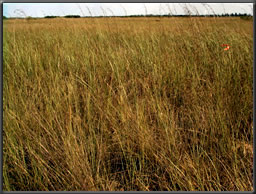

Marl and Rocky Flat Wetlands of the Florida EvergladeThis regional guidebook was developed to assess the functions of three subclasses of freshwater wetlands in the Florida Everglades: Rocky, Marl, and Organic Flats Wetlands. The subclasses are distinguished primarily by soil type but also have functional differences in hydrology (Table 5). In spite of the differences in the soils, flats wetlands in the Everglades have many functional similarities. The surface water flow is typically unidirectional, the soils poorly and very poorly drained and the terrain flat. They are primarily precipitation driven, but the surficial aquifers play an important role in their function. Seasonally high water tables in the surficial aquifers maintain the water levels necessary to support wetland communities. Rocky Flats The rocky glades are dominated by saw grass, muhly grass, panic grasses and beakrushes. The deeper solution holes are frequently filled with marl and submerged aquatics, such as bladderworts. Upland tree islands are also present in the rocky flats subclass. Typical wildlife includes southeastern five-lined skink, ringneck snake, pygmy rattlesnake, red-shouldered hawk, Carolina wren, eastern bluebird, pine warbler, opossum, marsh rabbit, cotton rat, cotton mouse, raccoon and bobcat (FNAI 1990). Marl Flats The oldest postglacial wetland sediment dated from the Everglades is calcitic mud, a freshwater,
frequently shelly, nonstratified, low-magnesium calcitic silt (Gleason and Spackman 1974). Marl is
formed as dissolved calcite (biochemical extraction of calcium carbonate from the movement of overlying
water) is reprecipitated as crystals or "needles" in a matrix of filaments of cyanobacteria (blue-green algae)
and green algae and diatoms in submerged algal mats (periphyton). Marl is defined as a limnic layer
(composed of organic and inorganic materials) with a moist Munsell color value of 5 or more that reacts with
dilute HCl to evolve CO2 (USDA 1999). Marls are found along coastal areas of Florida south of Lake Okeechobee
(Noble 1989, Cooper et al. 1995). In marl flats, the depths of the marl are 15 to 200 cm or greater (6 to 80+ in).
The average annual water levels are approximately 30 cm (12 in) with a duration of inundation for 2 to 9 months most years.
The oldest postglacial wetland sediment dated from the Everglades is calcitic mud, a freshwater,
frequently shelly, nonstratified, low-magnesium calcitic silt (Gleason and Spackman 1974). Marl is
formed as dissolved calcite (biochemical extraction of calcium carbonate from the movement of overlying
water) is reprecipitated as crystals or "needles" in a matrix of filaments of cyanobacteria (blue-green algae)
and green algae and diatoms in submerged algal mats (periphyton). Marl is defined as a limnic layer
(composed of organic and inorganic materials) with a moist Munsell color value of 5 or more that reacts with
dilute HCl to evolve CO2 (USDA 1999). Marls are found along coastal areas of Florida south of Lake Okeechobee
(Noble 1989, Cooper et al. 1995). In marl flats, the depths of the marl are 15 to 200 cm or greater (6 to 80+ in).
The average annual water levels are approximately 30 cm (12 in) with a duration of inundation for 2 to 9 months most years.
The environment for marl deposition is a sparsely vegetated marsh where the water surface is well lighted for the photosynthesizing algae and there is considerable oxidation of organic material in the sediment throughout the years, especially during the dry season (Gleason and Stone 1994). In order for marl to be deposited, the rate of deposition of organic material must be low in comparison with the rate of deposition of algally precipitated calcite. The hydroperiod and water depth can affect the rate of organic matter production by aquatic plants and the rate of decomposition of organic matter (Browder et al. 1994). The periphyton community, made up of many taxa of microalgae, serves as a food web base as well as building calcitic mud sediment, oxygenate the water column and form a substantial part of the vegetation biomass of the Everglades (Browder et al. 1994). Periphyton taxonomic composition is influenced by water quality (both nutrients and minerals) and hydroperiod (Browder et al. 1994). It grows well in areas where the water chemistry is affected by nearby limestone exposures and appears to be less affected by water depth and hydroperiod than by water quality (Gleason and Stone 1994) but appear to be excluded from areas of cattail monoculture and mixed dense sawgrass and cattail areas, which offers an explanation for depressed dissolved oxygen concentrations in these areas (Swift and Nicholas 1987). Periphyton is strongly season-dependent due to changes in the biomass of macrophytes (Vymazal and Richardson 1995). The presence of calcareous periphyton usually indicates a water depth of roughly 60 centimeters (cm) or less; at depths greater than 60 cm, the algal mat degenerates into a crumbly mass or a thin coating of algae (Browder et al. 1994). Dominant plants species in the marl Everglades include sawgrass, muhly grass, spikerush, bluestem, beakrush, and mermaid weed. Organic Flats The average annual water depth in organic flats is approximately 76 cm (30 in). The duration of inundation is 9 to 12 months. The organic glades are dominated by saw grass, maidencane, panic grasses, beakrushes and several floating and submerged aquatic species, such as mermaid weed, pickerel weed and bladderworts. The organic glades support populations of southern dusky salamander, cricket frog, little grass frog, chicken turtle, striped mud turtle, ringneck snake, cottonmouth, hawks, wild turkey, great horned owl, barred owl, pileated woodpecker, neotropical migratory birds, grey squirrel, black bear, raccoon, mink, river otter, bobcat and white-tailed deer (FNAI 1990). Guidebook
Web Date: October 1997 |